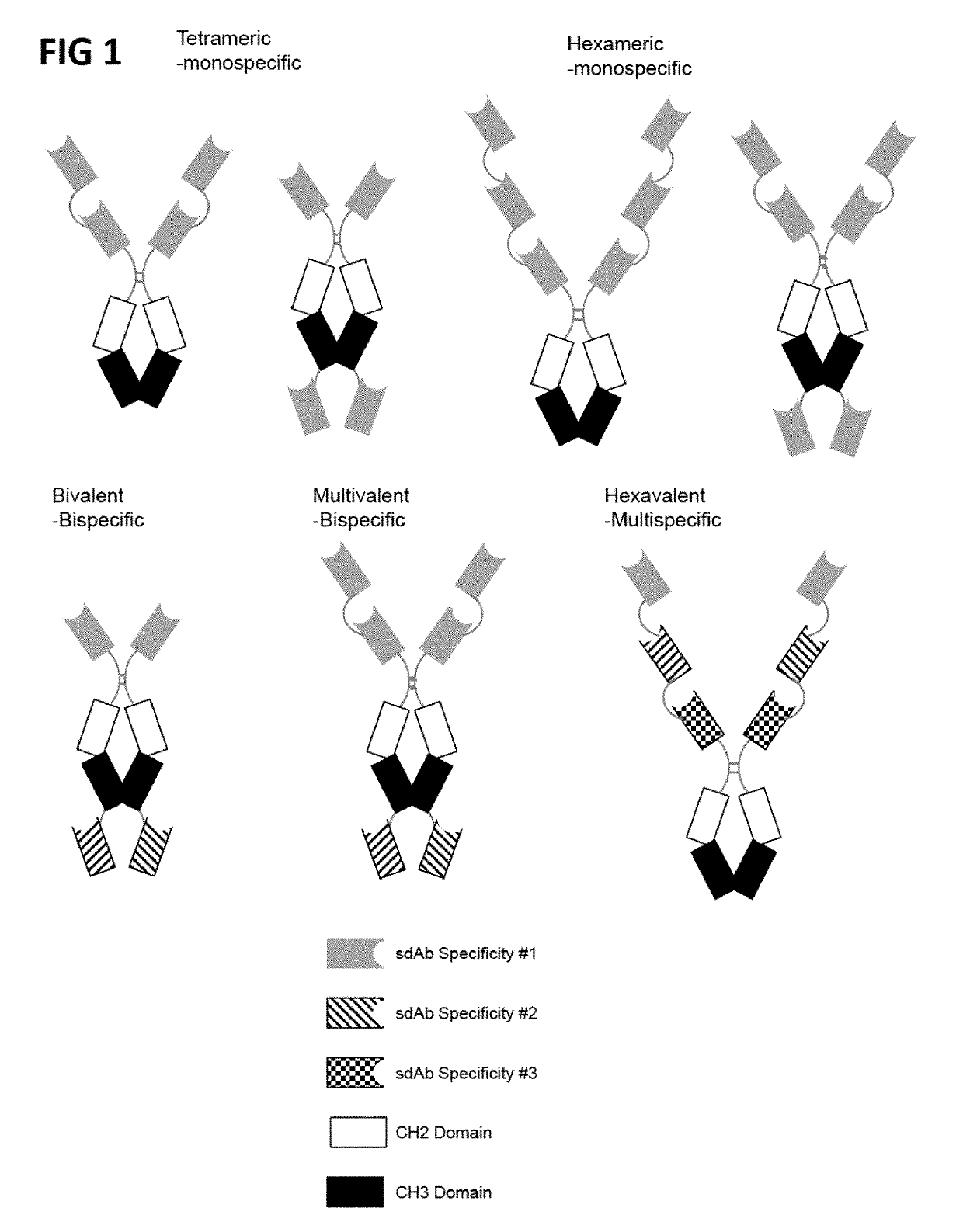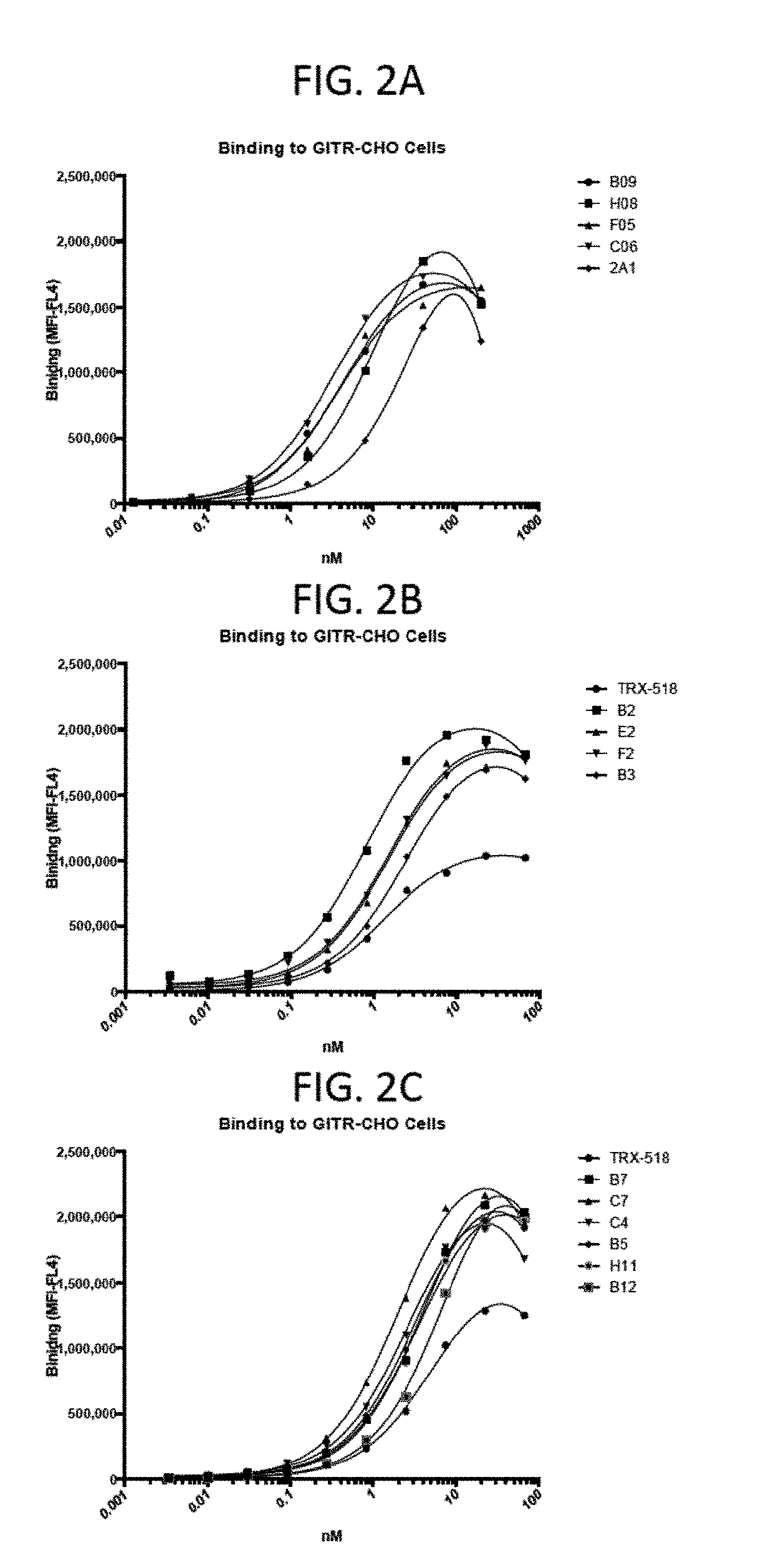Multivalent and multispecific gitr-binding fusion proteins
a fusion protein, multi-specific technology, applied in the direction of antibody medical ingredients, drug compositions, peptides, etc., can solve the problems of unsatisfactory conventional bivalent antibodies
- Summary
- Abstract
- Description
- Claims
- Application Information
AI Technical Summary
Benefits of technology
Problems solved by technology
Method used
Image
Examples
example 1
eting Molecules Bind GITR
[0178]As shown in FIGS. 2A, 2B, and 2C, various GITR-targeting fusion proteins of the disclosure bind to GITR expressed on CHO cells as assessed by flow cytometry. The GITR antibody, TRX-518, was used as a control for these studies.
[0179]The binding affinities of the GITR-targeting molecules referred to herein as hzC06v1.1 (SEQ ID NO: 42), hzC06v1.2 (SEQ ID NO: 43), hzC06v1.3 (SEQ ID NO: 44), hzC06v1.4 (SEQ ID NO: 45), hzC06v2.1 (SEQ ID NO: 46), hzC06v2.2 (SEQ ID NO: 47), hzC06v2.3 (SEQ ID NO: 48), hzC06v2.4 (SEQ ID NO: 49), hzC06v3 (SEQ ID NO: 50), hzC06v3.1 (SEQ ID NO: 51), hzC06v3.2 (SEQ ID NO: 52), hzC06v3.3 (SEQ ID NO: 53), hzC06v3.4 (SEQ ID NO: 54), hzC06v3.5 (SEQ ID NO: 55), hzC06v3.6 (SEQ ID NO: 56), hzC06v3.7 (SEQ ID NO: 57), hzC06v3.8 (SEQ ID NO: 58), hzC06v3.9 (SEQ ID NO: 59), hzC06v3.10 (SEQ ID NO: 60), hzC06v3.11 (SEQ ID NO: 61), hzC06v3.12 (SEQ ID NO: 62), hzC04v4.1 (SEQ ID NO: 63), hzC04v4.1.2 (SEQ ID NO: 64), hzC04v4.2 (SEQ ID NO: 65), hzC04v...
example 2
eting Molecules Block the Interaction Between GITR and GITR-L
[0180]As shown in FIGS. 3A, 3B, and 3C, various GITR-targeting fusion proteins of the disclosure were able to block the interaction between GITRL and GITR. Briefly, in these studies, a flow cytometry assay using GITR expressing CHO cells and recombinant GITRL was used to implement to assess blocking capacity. The GITR antibody, TRX-518, was used as a control for these studies.
example 3
ffinities of GITR-Targeting Molecules for Human and Cynomolgus GITR
[0181]The binding affinities of the GITR-targeting molecule referred to herein as bivalent hzC06v3.9-hIgG1 or 2×hzC06v3.9-IgG1 Fc (SEQ ID NO: 93) for human and cynomolgus GITR extracellular domain human IgG1 fusion protein (GITR-Fc) were determined by surface plasmon resonance. Briefly, biotinylated human and cynomolgus GITR-Fc were captured on the chip surface and then bivalent hzC06v3.9-hIgG1 was injected at 10 concentrations (0 nM-600 nM) at 40 ul / min for 120 seconds. Dissociation was followed for 240 seconds. ka1, kd1, and KD1 are reported in the table below.
GITR-Fcka1 (1 / Ms)kd1 (1 / s)KD(nM)Cyno1.22E+051.06E−0287.1Human 6.40E+054.12E−03 6.4
PUM
| Property | Measurement | Unit |
|---|---|---|
| molecular weight | aaaaa | aaaaa |
| molecular weight | aaaaa | aaaaa |
| dissociation constant | aaaaa | aaaaa |
Abstract
Description
Claims
Application Information
 Login to View More
Login to View More - R&D
- Intellectual Property
- Life Sciences
- Materials
- Tech Scout
- Unparalleled Data Quality
- Higher Quality Content
- 60% Fewer Hallucinations
Browse by: Latest US Patents, China's latest patents, Technical Efficacy Thesaurus, Application Domain, Technology Topic, Popular Technical Reports.
© 2025 PatSnap. All rights reserved.Legal|Privacy policy|Modern Slavery Act Transparency Statement|Sitemap|About US| Contact US: help@patsnap.com



